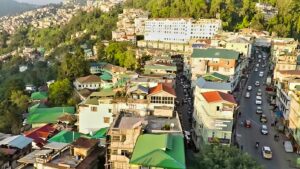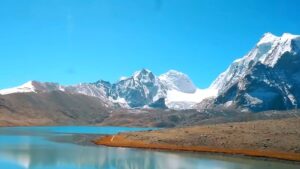Sikkim: The Land of Diversity and Natural Wonders

From some of the world’s highest lakes to breathtaking views of the snow-capped Himalayas, from lush-green subtropical woodlands to rhododendron groves blooming with flowers, and from the mural-filled monasteries of Tibetan Buddhism to the pristine Hindu shrines of the Nepali community, Sikkim is a land of richness and diversity. Whether you’re seeking a high-altitude trek through hidden mountain trails or a relaxing holiday at a luxury hotel with views of Kanchenjunga, Sikkim has it all.
If you’re planning a trip to Sikkim, here’s your ultimate Sztravelblog guide for everything you need to know. Home to the third-highest peak in the world, Kanchenjunga, Sikkim was once considered a princely state during British rule and remained an autonomous kingdom until 1975 when it became part of India.
Nestled in the eastern Himalayas, Sikkim is bordered by Tibet to the north and northeast, Bhutan to the east, Nepal to the west, and West Bengal to the south. Beyond its natural beauty, Sikkim has also been recognized as the world’s first 100% organic state by the United Nations, adding another layer to its unique charm.
Best Time to Visit Sikkim

Sikkim experiences four distinct seasons: winter, summer, autumn, and monsoon. The best time to visit is from mid-April to July, when the weather is pleasant, with temperatures ranging from 28 to 30 degrees Celsius. This is also the time when the skies are clear, offering stunning views of the Himalayan peaks.
The monsoon months of August and September bring heavy rains, while October, with its crisp autumn air, is another popular time for tourists. For those seeking snowfall and a true winter experience, visit between November and March, when temperatures often drop below zero degrees.
How to Reach Sikkim

Historically, Sikkim was accessible only by road from neighboring states, but now you can fly to Bagdogra Airport in West Bengal or take a train to New Jalpaiguri (NJP) Station, followed by a cab ride into the hill towns of Sikkim. The roads are smooth, and the scenic drive offers splendid views.
The newly inaugurated Pakyong Airport near Gangtok is a step toward improved connectivity, though it currently operates limited flights. While planning your trip, decide which region of Sikkim you want to explore, as each part offers something unique.
Exploring East Sikkim: Gangtok and Beyond

The capital city of Gangtok, located in East Sikkim, is a bustling hub for tourists. Here, you can explore local markets, Insta-worthy cafes, and even try your luck at the city’s casinos. Popular nearby attractions include Rumtek Monastery, Tsomgo Lake, Nathu La Pass, and Baba Harbhajan Singh Temple. The historic Old Silk Route, a key trade link between the East and the West, also runs through this region.
Discovering North Sikkim: Lachung, Lachen, and Gurudongmar Lake

After spending a few days in Gangtok, venture to North Sikkim, where you can explore the stunning valleys of Lachung and Lachen. Drive uphill to the mesmerizing Gurudongmar Lake, sitting at an altitude of 17,800 feet. Along the way, visit picturesque spots like Yumthang Valley and Yumesamdong.
West Sikkim: Kanchenjunga Views and Trekking

West Sikkim offers one of the best views of Mt. Kanchenjunga, particularly from the town of Pelling. For trekkers, this region is home to high-altitude treks like the Goecha La, starting from the quaint town of Yuksom. You can also hike through dense forests to Khecheopalri Lake, a sacred site for Buddhists, or visit the ancient monasteries of Pemayangtse and Sangachoeling.
South Sikkim: Serenity and Spirituality

If you’re seeking peace and solitude, South Sikkim is the perfect retreat. Explore the Rangit Valley, wander through Namchi’s hidden trails, visit the grand Buddha Park at Ravangla, and experience local hospitality at homestays in Borong. The region offers a slower pace of life, surrounded by forests and hills.
Accommodation in Sikkim

Sikkim offers a diverse range of accommodation options, from luxurious properties to budget hotels, backpacker hostels, and affordable homestays.
In Gangtok, you can stay at Sinclairs, which offers a mountain-facing infinity pool, or at the Mayfair Hotel, where you can try your luck at the casino. Additionally, there are several hotels in and around MG Marg, the most popular part of town. Hostels like Tagalong Backpackers and Zostel are preferred by solo travelers and trekkers.
Pelling also boasts some unique luxury properties, such as Hotel Elgin, which offers stunning views of Mt. Pandim from every room.
In smaller towns like Lachung, Lachen, and Yumthang, homestays are the primary accommodation option, where hosts warmly welcome you and treat you like family. For a unique experience, you can even spend a night at local monasteries, where rooms are occasionally available.
Food in Sikkim: A Culinary Journey

The cuisine in Sikkim is a delightful blend of Nepali and Tibetan influences, with popular dishes like momos, thenthuk, and thukpa readily available across the state. But there’s a lot more to discover beyond these well-known delicacies.
When in Gangtok, make sure to visit Thakali to try the authentic Nepali Thali—a must-have meal that captures the essence of local flavors. As you explore Sikkim’s eateries, be adventurous and try Phagshapa—a dish made from strips of pork fat, stewed with dry chilies and radish. Pair it with Chaang, a local alcoholic beverage brewed from fermented millets and served warm.
Another must-try is Sael Roti, a soft pretzel-like bread often served with potato curry. And don’t leave Sikkim without tasting Churpi, the traditional local cheese made from yak milk, hardened to a toffee-like texture. It’s a unique treat that reflects the high-altitude lifestyle of the locals.
Indulging in these local delicacies is an integral part of the Sikkim experience, offering a flavorful insight into the state’s diverse culture.
Must-Visit Places in Sikkim: Monasteries

Soak in the peaceful vibes and witness the beauty of Sikkim’s monasteries. This small Himalayan state is home to more than 200 monasteries, known locally as Gompas. These spiritual sanctuaries play a significant role not only in shaping Sikkim’s cultural heritage but also in deeply influencing the lifestyle of its people.
A visit to Sikkim would be incomplete without exploring some of these centuries-old monasteries. Many of them date back to the 14th century, and they house beautiful wall paintings, intricate murals, and sacred scriptures placed carefully inside the main sanctum.
Here are some of the most popular monasteries that you should visit:
1.Rumtek Monastery – One of the largest and most significant monasteries in Sikkim.
2.Pemayangtse Monastery – Known for its ancient murals and panoramic views.
3.Tashiding Monastery – Considered one of the holiest in Sikkim, offering spiritual tranquility.
4.Enchey Monastery – Famous for its striking architecture and serene surroundings.
5.Phodang Monastery & Phensang Monastery – These monasteries are known for their beautiful designs and peaceful ambiance.
These monasteries also host vibrant festivals where monks perform masked dances, adding color and life to the peaceful surroundings. Attending one of these festivals is an experience you shouldn’t miss!
Exploring the Challenging Roads of Zuluk Loops

At an elevation of 11,000 ft, Zuluk Loops offers one of the most exhilarating drives you’ll ever experience. Historically, this route was a vital part of the ancient Silk Road, facilitating trade between the East and West, and becoming a hub for cultural and commercial exchange.
The Zuluk Loops are famous for their thirty-two hairpin bends, making it a thrilling journey for adventurous travelers. As you navigate these winding roads, you’ll be treated to breathtaking views of the surrounding mountains and valleys, making the drive as mesmerizing as it is challenging.
The village of Zuluk provides homestay accommodations, allowing travelers to immerse themselves in the rich local culture. Staying here gives you the chance to learn about the history of the Silk Route and experience the unique lifestyle of the people living in this remote region.
A journey through Zuluk is truly a one-of-a-kind adventure, perfect for those seeking both a test of their driving skills and an authentic cultural encounter.
Frozen Guru Dongmar Lake

Situated at an altitude of 17,800 ft, Guru Dongmar Lake is one of the highest glacial lakes in the world. The lake, surrounded by the rugged beauty of the majestic Himalayas, is truly a sight to behold, especially when frozen. Its serene, almost ethereal beauty, coupled with the towering presence of the sacred peak Khangchen Gyao, will leave you speechless.
This lake is not only a natural wonder but also a place of deep spiritual significance. According to popular folklore, Guru Padmasambhava, an 8th-century Buddhist master, stopped here to drink water while on his journey from Tibet to India, and ever since, the lake has been considered holy by Buddhists.
Located just five kilometers from the Tibetan border, access to Guru Dongmar Lake is limited to the summer months when the roads are passable. The journey to the lake is as unforgettable as the destination itself, offering travelers a unique opportunity to witness both the beauty of nature and the spiritual essence of this sacred site.
Explore the Valley of Flowers at Yumthang

Often referred to as the ‘Valley of Flowers,’ Yumthang Valley is one of the most picturesque villages in Sikkim and a true paradise for nature lovers. Nestled amidst the majestic Himalayas, this enchanting valley is home to the Shingba Rhododendron Sanctuary, which boasts over 24 species of Rhododendron flowers that bloom vibrantly from late February to mid-June.

In addition to its stunning floral displays, Yumthang Valley features lush green meadows where yaks graze peacefully throughout the day. Visitors will also discover rare hot springs in the area, renowned for their supposed miraculous healing properties. These natural springs attract tourists seeking relaxation and rejuvenation, making Yumthang Valley a must-visit destination for those looking to connect with nature.
Hike Through Kanchenjunga National Park

Kanchenjunga National Park, named after the third highest mountain peak in the world, is nestled in the lap of the majestic Himalayas and is recognized as a UNESCO World Heritage Site. Spanning a vast area of 850 square kilometers, the park is home to a rich diversity of endemic and rare species of flora and fauna, including the elusive Snow Leopard and the Himalayan Tahr.

This breathtaking national park adjoins the Qomolangma National Nature Preserve in Tibet, making it a critical part of the region’s ecosystem. Numerous trekking routes meander through the park, with the trail to Goecha La being particularly notable; it is often regarded as one of the most romantic treks in India, offering stunning views and an unforgettable experience for nature enthusiasts.
How Many Days Should You Spend in Sikkim?

When planning your trip to Sikkim, a duration of 8 to 10 days is ideal for exploring the state’s diverse landscapes and attractions. This timeframe allows you to cover significant regions, ensuring you don’t miss out on the must-see spots while enjoying the natural beauty and cultural richness Sikkim offers.
To make the most of your visit, prepare a well-thought-out itinerary that includes all the experiences you wish to tick off your travel bucket list. Whether you’re trekking through breathtaking valleys, visiting serene monasteries, or indulging in the local cuisine, every moment spent here will create lasting memories. No matter how long you stay, the enchanting charm of Sikkim will linger in your heart, leaving you yearning for more adventures in this beautiful state.


1 thought on “Discover the Best Places to Explore in Sikkim in 2024”